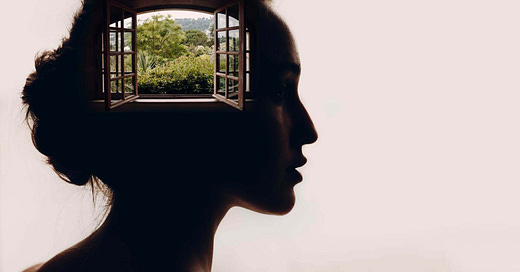The biggest risk is in not doing it.
Whatever it is.
Fear lives in your neural pathways. Not only fear, but comfort, fondness, safety and a slew of other things you feel as you go about your life, chasing or not chasing dreams. These feelings arise from the deep grooves of the habits you’ve formed, thought patterns you follow, in the things you believe.
About everything.
I am enthralled with this small fact. Not only because belief has affected every corner of my life, but because belief can change. What you believe about yourself, your circumstances, your past, present and future–your beliefs about how the world came to be and how it will continue–can and will change.
Belief is affected by choice and also affects choice. We’ve got a bit of a chicken and egg scenario here.
The famous scene in Indiana Jones and the Last Crusade comes to mind. Indy stands on one side of a precipice, his prize waiting on the other, with nothing between but a deep, dark chasm.
The clue tells him to step off the ledge, and as he sweats and clenches his teeth, he takes the step. To his great surprise, he does not fall to his death. He finds a hidden path, cut intentionally so that it is invisible to the onlooker, waiting to usher him to his prize.
He chose the risk. The belief that his clues were correct, that the only way across was to go blindly forward, outweighed the belief that he would fall.
I know you’ve been so afraid to do something that you haven’t done it. That’s being human, especially a human child. I remember the really, really high diving board.
The PLATFORM. *lightning strikes*
I’d stand up there, staring down at the pool, my mother cheering me on.
“You’ve got it,” she called from the shallow end.
Eventually I’d choose the risk, surmounting fear and splashing into the pool seconds later. The thrill of it was like a drug to my young brain. The surge of “feel good” chemicals sent me back up that ladder over, and over, and over.
All fueled by belief.
And then there’s the opposite, when you don’t jump. That’s belief, too. That’s a choice fueled by a different set of beliefs, usually that the risk is too big or too scary or that you’ll hurt yourself and drown.
And sometimes, you’ll hurt yourself and drown. Without that factor–the ever-present fear of failure, of pain and discomfort–the risk would be null. When I think about this balance between desiring something and fearing it at the same time, I think of a cat.
If you’ve ever watched a cat think about jumping, you know what I mean. They poise themselves, their muscles tense, and you can see the scale tip from yes to no and back again as they nervously reposition their feet and take half-starts, all the while staring at their destination.
It’s like the moment when Indiana Jones closes his eyes and steps off the ledge.
You just have to do it scared.
I think belief is an important part of everything we do. It’s no wonder another term for play, especially in reference to children, is make believe.
When I was a child, the worlds through which I traveled in my mind were vast and limitless. My imagination was bolstered by our backyard, our animals, my sister and the small stream that ran behind our house. I stalked alongside my cats, watched tadpoles grow to frogs, spent hours pretending my sister and I were on a long, wild adventure across verdant meadows with only ourselves and what we could carry.
My imagination still gets plenty of exercise. As adults, we need to continue the practice of making believe. It’s good for the mind.
Whatever feels like play to you, do that.
Belief, in a larger sense, affects the world in drastic ways. Whether we mean it to or not, the things we believe make their way into culture. Aspects of society in the United States, for example, reflect Christianity. Pieces of Middle Eastern culture reflect Islam, while Asian culture reflects Hinduism, Buddhism, Taoism, etc.
These observations nod to the power of beliefs themselves, reminding us that what we hold to be true in our minds shapes not only who we become as individuals, but who we become as a whole.
Belief can be dangerous. It can drive people to extreme behavior. It can become a tool for manipulation. It can divide families and cause prejudices. Belief has a dark side, like anything else.
Belief must be doubted. It is not absolute, as we would like it to be. Doubt is merely a process of questioning belief, whether to confirm or to change. What’s more, there is this small fact: belief does not affect whether or not something is true.
Of course, shifting sands of belief surround us constantly, no matter where you live. In
a time when the entire globe is connected, it will be interesting to see what beliefs emerge, and which fade away, as we continue to cross cultural lines.
On a personal note, I will say that belief has shaken me to my core in my lifetime, and I found a growing need to seek truth rather than attach myself to any set of beliefs, no matter how shiny and neat they look.
One thing I believe is some mysteries are better unsolved. In some corners of my mind are question marks, and I am happy with them. I’m happy with the mystery.
To me, it feels like play.



